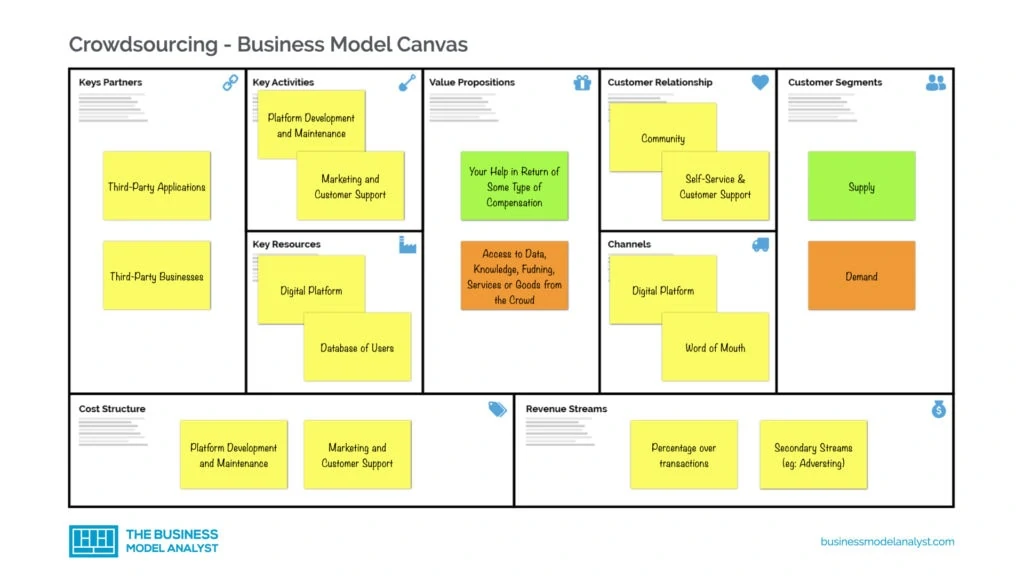As the name suggests, the crowdsourcing business model refers to when the crowd act as a source for the business – usually some multisided platform. There are many options of crowdsourcing, but all of them involve opening tasks of issues to a large group in order to receive their input for operation. The “crowd’ of this business model may be made up of customers, ordinary citizens, specialists, other entrepreneurs, and business owners/managers, etc. The company is going to employ their knowledge to benefit your business. For this knowledge to be acquired, the business must create solutions for the user to get interested in collaborating, and, at the same time, earn money as a business. Let’s go a little deeper.
Contents
What is Crowdsourcing?
Crowdsourcing usually involves getting work, information, and/or opinion from a large group of people, through the Internet, social media, and smartphone apps. Sometimes these people are paid as freelancers, sometimes they do it on a voluntary basis. Quite often, the wisdom of the group is more frequent or assertive when it is applied to solve some problem in an innovative way. For example, the Waze traffic app uses crowdsourcing because it asks for drivers to report accidents and incidents to offer real-time updated information to the users. So, as the users see value in that, they participate, voluntarily.
Why Crowdsourcing?

Although crowdsourcing has basically been there for centuries, the term was first used by Jeff Howe in 2006, when he wrote an article about the crowdsourcing business model. This business model gained popularity first with the internet and, even more, with social media and smartphones. Crowdsourcing is a good practice because it allows the company to raise information and expertise from people all over the world, without having to actually hire them as regular employees – with all the costs involved in that. To make crowdsourcing work well, the business must first break the big project into micro-tasks. So, the company will probably use a digital space (the crowdsourcing platform) to put everything together. And, generally, when the business aims to gather customer data, it may turn to social media to crowdsource information from users.
Benefits of Crowdsourcing

- Accelerated processes: crowdsourcing makes tasks and processes quicker, due to the possibility of breaking up the project among a large group of workers, then accelerating the whole venture.
- Consumer engagement: crowdsourcing asks for consumer participation in solving problems or providing information. This will hold the consumer’s attention for much longer since they feel part of the project. This attention can be turned into earning in a short time.
- Reduced costs: crowdsourcing is also a cheaper way to accomplish the project. Since the workers are not regular employees, with full salaries, training, offices and more. The operational costs are smaller, then.
- Scalability: scaling can cause a company a hard time, especially in the beginning or when the project does not have the necessary resources to start running. Crowdsourcing permits the business to farm out micro-tasks to be completed by remote workers anytime, anywhere.
- Knowledge gaps: crowdsourcing allows the business to access people with skills that are not available among its own human resources because sometimes it is not worthy to hire some specialized professional who will be really useful only for some specific project.
Types of crowdsourcing business models

Crowdsourcing Data
One of the most common forms of crowdsourcing is to crowdsource information to enhance the value of a business product or service. A famous example is the one mentioned above, of mobile GPS apps, such as Waze. In this kind of apps, users can enter data about traffic jams, hazards, police radar and actions, and much more. This will be visible to any other users. So, all of the users will benefit from the information from each other. That turned the traffic app into a community, with engaged users who enhance the value for everyone.
Open-Source Software
Another very common type of crowdsourcing is open-source software. This allows any developers to access the software source code in order to modify or improve it. The result is a lot of people together making the system better. Some famous examples include Linux operating systems and Firefox browsers.
Crowdfunding
Some people don’t agree that crowdfunding is a type of crowdsourcing since seeks information, content, and opinion, whereas crowdfunding seeks money to support some project, charity, startup, individuals, or something like that. Crowdfunding would be basically a donation, with no expectations. On the other side, the process allows people interested in the original idea to raise capital, avoiding banks or investors, for example. A famous example is the Oculus headset.
Crowdsourcing business model

- Value Propositions: Access to Data, Knowledge, Funding, Services or Goods from the Crowd; and Your help in return of some type of compensation (usually monetary or social);
- Customer Segments: a supply (crowd) and demand (customers or users);
- Channels: the company provides its service to the customers via the internet (mobile application and websites) to its digital platform. Word of mouth is usually very strong between users;
- Customer Relationships: digital platforms allow self-service use added of customer service. The strong sense of community is also very present;
- Revenue Streams: in general, the revenue streams are a percentage of the transactions. When there’s no monetary exchange, secondary streams such as advertising are used;
- Key Resources: the most important assets to make the business model work is the information or data the crowd produces as well as the digital platform that enables it;
- Key Activities: the activities are platform development and maintenance, marketing and customer support;
- Key Partners: third-party applications and businesses.
- Cost Structure: usually cheaper than a regular company, but still includes fixed and variable costs, technical development costs, marketing and customer support.

